Nanorobotics Market Size
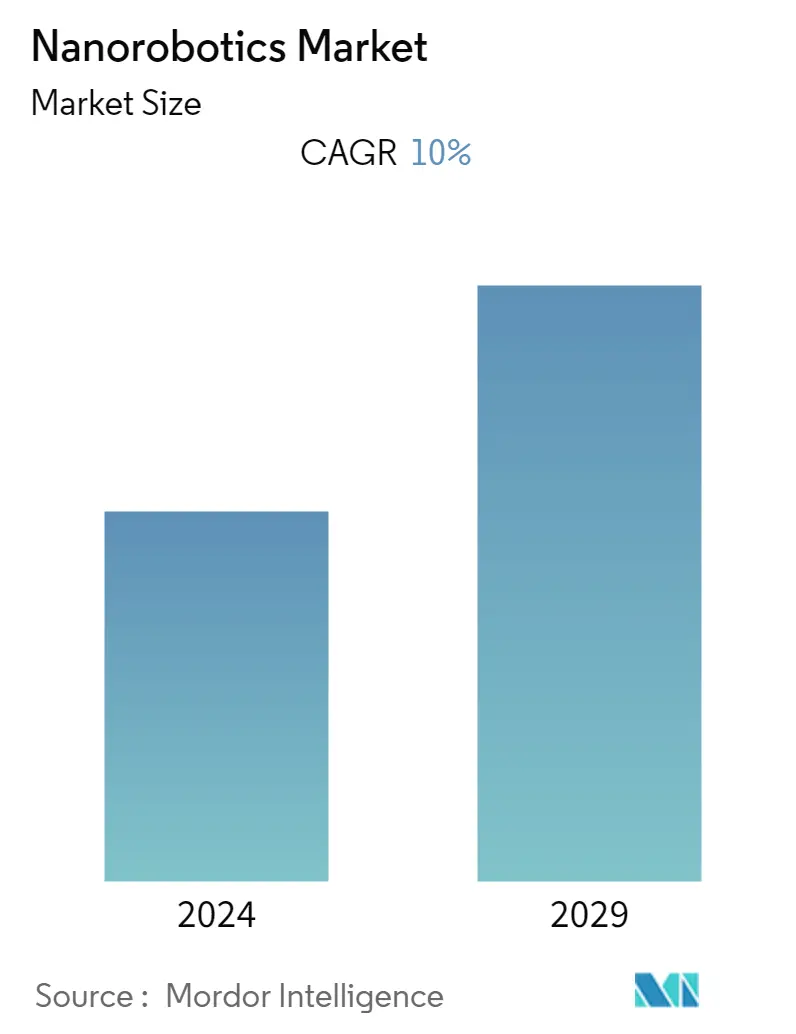
| Study Period | 2019 - 2029 |
| Base Year For Estimation | 2023 |
| CAGR | 10.00 % |
| Fastest Growing Market | Asia Pacific |
| Largest Market | North America |
| Market Concentration | High |
Major Players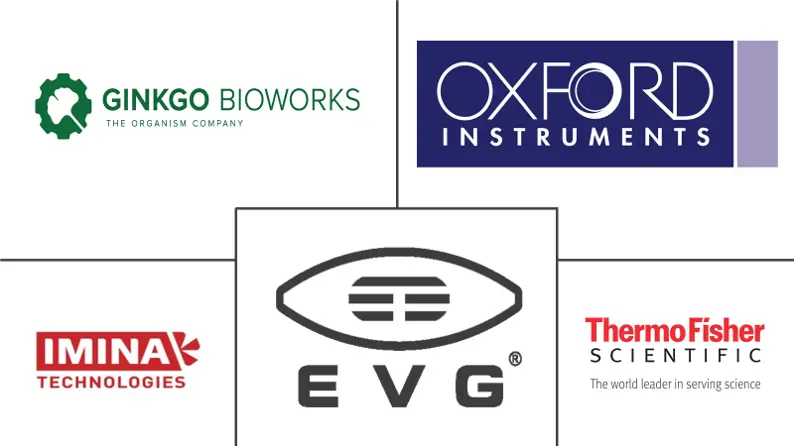
*Disclaimer: Major Players sorted in no particular order |
Nanorobotics Market Analysis
The nanorobotics market registered a CAGR of 10% during the forcasted period (2021-2026). Nanorobotics refers to nanotechnology that involves engineering, designing, and building of nanorobots. Nanorobots are devices ranging in size from 1 to 100 nanometers that are composed of nanoscale or molecular components.
- Nanobots are injected into the patient to perform diagnosis or treatment on a cellular level, and the diagnosis or treatments involve the nanoscale, molecular, or atomic level. Treatments with nanorobots may include alterations in the structure and composition at the molecular or submolecular level. The various areas of applications of nanorobots leverage the unique properties of materials and devices in the nanoscale dimensions.
- In 2019, dozens of startups looked to get in on this emerging new field. One of those is Pumeram, which is based in Prague and has already raised EUR 11.5 million to develop rocket, spheroid, and even screw-shaped nanobots that will help treat diseases ranging from skin and oral ailments to fertility problems. The startup's cancer-killing nanobots have already been successfully tested on mice.
- The tech giant, Google, partnered with the big pharma giant GlaxoSmithKline to form its nanobot powerhouse shows the significance of nanorobotics in the future. Eligo, a startup founded in France, raised USD 27.4 million till mid-2019 to put protein-based nanobots in the bowels and is now focused on moving different clinical programs into humans.
- In 2020, researchers around the world are developing skilled nanobots that can perform a wide range of surgeries on humans. They will be programmed and guided with external magnetic fields. Nanobots can perform eye surgeries with needles, clear blocked arteries by drilling a corkscrew through arterial blockages and collect biopsies.
- Since the coronavirus outbreak began in late 2019, researchers are racing to learn more about SARS-CoV-2, which is a strain from a family of viruses known as coronavirus for their crown-like shape. Various researchers are proposing the idea of using nanoparticles that are a similar size to the virus behind COVID-19 that could attach to SARS-CoV-2 viruses, disrupting their structure with a combination of infrared light treatment and this expected to boost the market if the practice succeeds.
Nanorobotics Market Trends
This section covers the major market trends shaping the Nanorobotics Market according to our research experts:
Drug Delivery Application is Expected to Witness Significant Growth Rate
- Nanobots are an emerging field, showing great potential as a form of drug delivery. The ability to target difficult-to-reach areas of the body while carrying medicinal compounds is highly sought after as a biomedical application. Although there are still advances to be made in the field, previous research indicates that they will be vital in combatting hard-to-treat diseases. A significant challenge for most researchers, however, is ensuring that their concepts will be successful on the nanoscale.
- In the last few years, research into engineered nanobots that can navigate through the body to deliver drugs with precision has intensified. In December 2019, Researchers from IIT Guwahati had come up with nanobots synthesized from tea extracts, named ‘teabots,’ which can serve as biocompatible drug-delivery agents.
- In September 2019, Michigan State University scientists invented a new way to monitor chemotherapy concentrations, where they created a process based around magnetic particle imaging that employs superparamagnetic nanoparticles as the contrast agent and the sole signal source to control drug release in the body at the site of the tumor. Nanobots are used to target harder-to-reach portions of cancerous tumors, which will be a potential increase in the chances of successful chemotherapy as well.
- In 2019, DNA nanorobots were developed, which consists of a track and a walker system to reach the target location and contained a self-assembly system consisting of DNA strands with the ability to produce a functional molecule. All the concepts and designs proposed by the researchers for nanorobots in the drug delivery application are successful and promising. Yet, improvements are needed before being deployed on a larger scale.
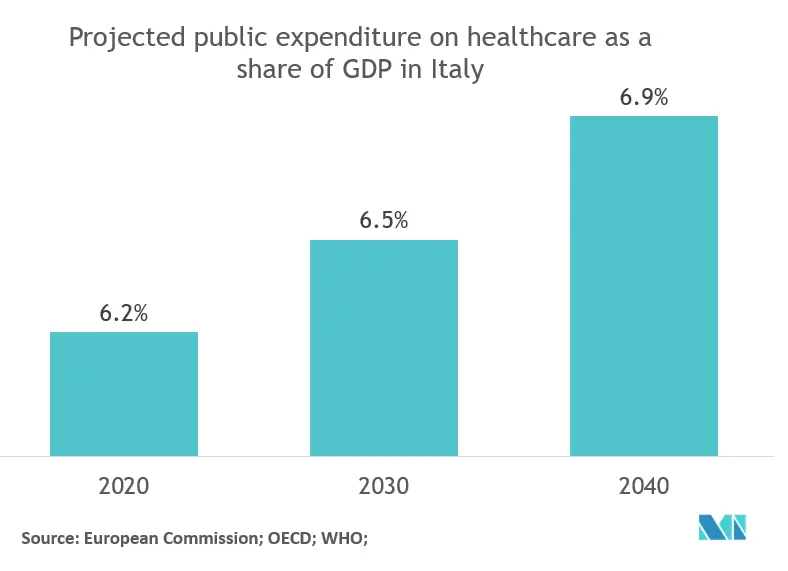
North America is Expected to Hold a Major Share
- North America is expected to hold a major market share over the forecast period. One of the driving factors for the region’s growth is the considerable growth in the backing of nanorobotics from the Defense Advanced Research Projects Agency (DARPA) and the National Science Foundation (NSF). The growth of adoption in nanotechnology, coupled with high expenditure on healthcare, is expected to create a positive impact on the market in the region.
- The United States has one of the highest costs of healthcare in the world. In 2018, the United States spent about USD 3.6 trillion on healthcare, which averages to about USD 11,000 per person. The Centers for Medicare and Medicaid Services (CMS) project that by 2028, such costs will climb to USD 6.2 trillion, or about USD 18,000 per person, and will represent about 20 percent of GDP. As most of the applications of nanorobotics are related to health care, the region is expected to witness the increase in the adoption of the technology in such related applications.
- However, the most direct impact the coronavirus pandemic will have on U.S. health care spending is through testing and treatment of COVID-19. The University of Washington Institute for Health Metrics and Evaluation (IHME) model suggests the outbreak is reaching its peak in the U.S. and is bound to put a severe strain on the government in terms of spending to tackle the virus. Although researchers are contemplating the idea of using nanoparticles to combat the virus, the idea is still in a nascent stage, and the research activities of nanorobotics backed by the government may witness significant delays.
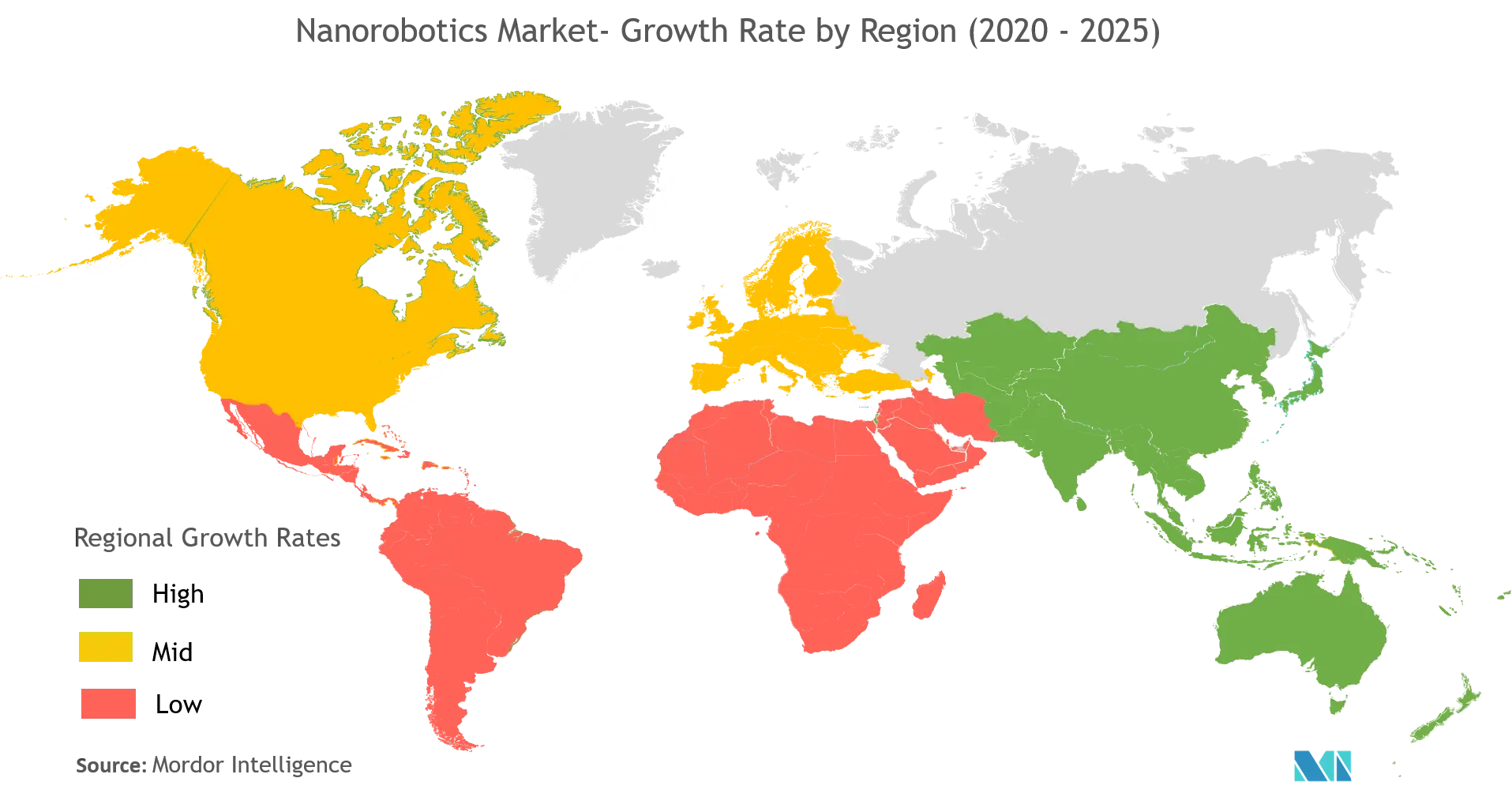
Nanorobotics Industry Overview
The nanorobotics market is highly consolidated and consists of a few significant players. In terms of market share, few of the major players currently dominate the market as the technology is still in a developmental phase. The companies and researchers are yet to deploy the applications of nanorobotics commercially. However, the growth of certain start-ups is expected over the forecast period.
- June 2019 - EV Group launched a fully integrated track system that combines cleaning, resist coating, and baking pre-processing steps with the company's proprietary SmartNIL wafer-level nanoimprint lithography process in a single platform for wafers up to 300 millimeters in diameter. It supports the production of a variety of devices and applications, including optical devices for augmented/virtual reality (AR/VR) headsets, 3D sensors, bio-medical devices, nanophotonics, and plasmonics.
Nanorobotics Market Leaders
-
Ginkgo Bioworks Inc
-
Imina Technologies S.A.
-
Oxford Instruments
-
EV Group
-
Thermo Fisher Scientific Inc
*Disclaimer: Major Players sorted in no particular order
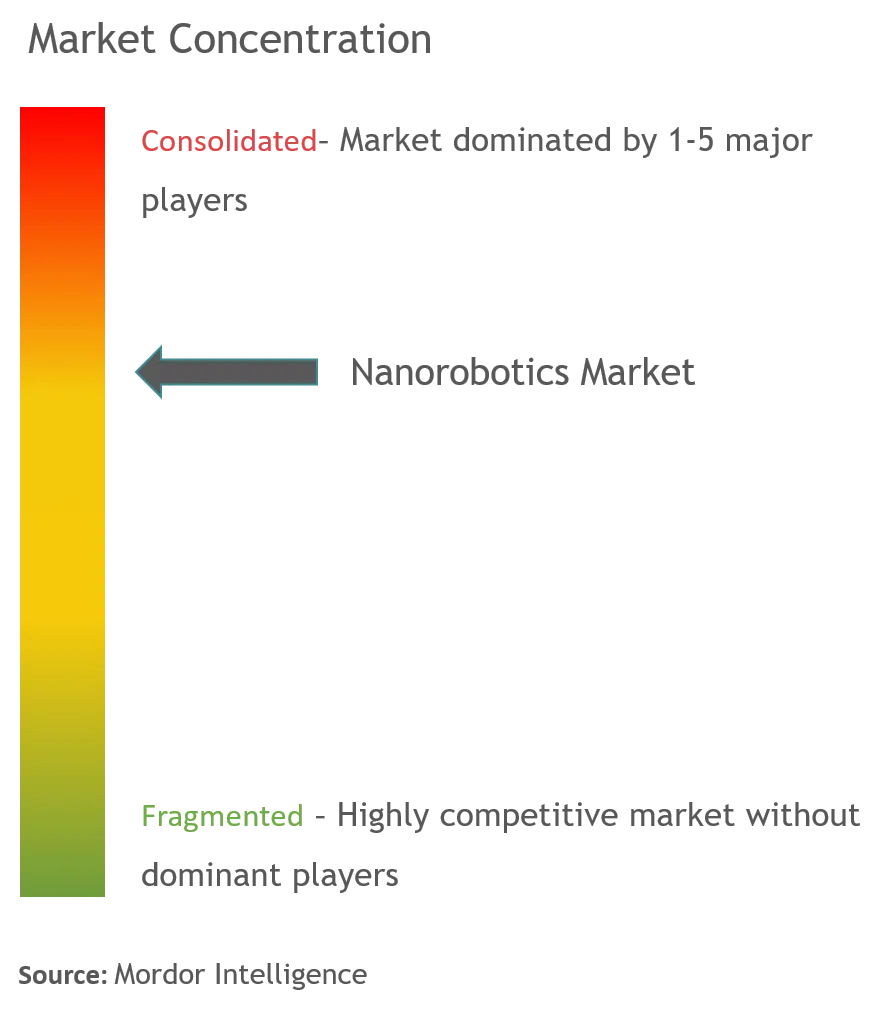
Nanorobotics Market Report - Table of Contents
1. INTRODUCTION
- 1.1 Study Deliverables
- 1.2 Study Assumptions
- 1.3 Scope of the Study
2. RESEARCH METHODOLOGY
3. EXECUTIVE SUMMARY
4. MARKET DYNAMICS
- 4.1 Market Overview
-
4.2 Market Drivers
- 4.2.1 Increasing Investment in Technology by Governments and Universities
- 4.2.2 Growing Demand for Advanced Medical Treatments
-
4.3 Market Restraints
- 4.3.1 High Manufacturing and Development Costs
-
4.4 Industry Attractiveness - Porter's Five Forces Analysis
- 4.4.1 Threat of New Entrants
- 4.4.2 Bargaining Power of Buyers/Consumers
- 4.4.3 Bargaining Power of Suppliers
- 4.4.4 Threat of Substitute Products
- 4.4.5 Intensity of Competitive Rivalry
- 4.5 Technology Snapshot
- 4.6 Assessment of Impact of COVID-19 on the Industry
5. MARKET SEGMENTATION
-
5.1 Type of Manufacuturing
- 5.1.1 Biochips
- 5.1.2 Nubots
- 5.1.3 Bacteria-based Nanobots
- 5.1.4 3D Printing
- 5.1.5 Other Types
-
5.2 Application
- 5.2.1 Medical Imaging
- 5.2.2 Information Storage
- 5.2.3 Drug Delivery
- 5.2.4 Health Sensors and Replicators
- 5.2.5 Other Applications
-
5.3 Geography
- 5.3.1 North America
- 5.3.1.1 Unites States
- 5.3.1.2 Canada
- 5.3.2 Europe
- 5.3.2.1 Germany
- 5.3.2.2 United Kingdom
- 5.3.2.3 France
- 5.3.2.4 Rest of Europe
- 5.3.3 Asia-Pacific
- 5.3.3.1 India
- 5.3.3.2 China
- 5.3.3.3 Japan
- 5.3.3.4 Rest of Asia-Pacific
- 5.3.4 Rest of the World
- 5.3.4.1 Latin America
- 5.3.4.2 Middle-East and Africa
6. COMPETITIVE LANDSCAPE
-
6.1 Company Profiles
- 6.1.1 Ginkgo Bioworks Inc
- 6.1.2 Imina Technologies SA
- 6.1.3 Oxford Instruments
- 6.1.4 EV Group
- 6.1.5 Thermo Fisher Scientific Inc.
- 6.1.6 Zymergen Inc.
- 6.1.7 Illumina Inc.
- 6.1.8 Nanoics Imaging Limited
- 6.1.9 Synthace Limited
- 6.1.10 Toronto Nano Instrumentation Inc.
- *List Not Exhaustive
7. INVESTMENT ANALYSIS
8. MARKET OPPORTUNITIES AND FUTURE TRENDS
** Subject To AvailablityNanorobotics Industry Segmentation
Nanorobots can be manufactured using various types of techniques, which include biochips, nubots, bacteria-based, 3D Printing, and can be used in various applications, such as drug delivery, medical imaging, information storage, health sensors, and replicators.
| Type of Manufacuturing | Biochips | |
| Nubots | ||
| Bacteria-based Nanobots | ||
| 3D Printing | ||
| Other Types | ||
| Application | Medical Imaging | |
| Information Storage | ||
| Drug Delivery | ||
| Health Sensors and Replicators | ||
| Other Applications | ||
| Geography | North America | Unites States |
| Canada | ||
| Geography | Europe | Germany |
| United Kingdom | ||
| France | ||
| Rest of Europe | ||
| Geography | Asia-Pacific | India |
| China | ||
| Japan | ||
| Rest of Asia-Pacific | ||
| Geography | Rest of the World | Latin America |
| Middle-East and Africa |
Nanorobotics Market Research FAQs
What is the current Nanorobotics Market size?
The Nanorobotics Market is projected to register a CAGR of 10% during the forecast period (2024-2029)
Who are the key players in Nanorobotics Market?
Ginkgo Bioworks Inc, Imina Technologies S.A., Oxford Instruments, EV Group and Thermo Fisher Scientific Inc are the major companies operating in the Nanorobotics Market.
Which is the fastest growing region in Nanorobotics Market?
Asia Pacific is estimated to grow at the highest CAGR over the forecast period (2024-2029).
Which region has the biggest share in Nanorobotics Market?
In 2024, the North America accounts for the largest market share in Nanorobotics Market.
What years does this Nanorobotics Market cover?
The report covers the Nanorobotics Market historical market size for years: 2019, 2020, 2021, 2022 and 2023. The report also forecasts the Nanorobotics Market size for years: 2024, 2025, 2026, 2027, 2028 and 2029.
Nanorobotics Industry Report
Statistics for the 2024 Nanorobotics market share, size and revenue growth rate, created by Mordor Intelligence™ Industry Reports. Nanorobotics analysis includes a market forecast outlook 2029 and historical overview. Get a sample of this industry analysis as a free report PDF download.



